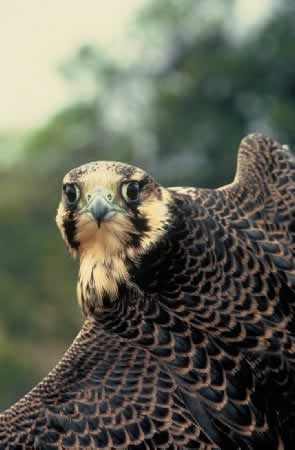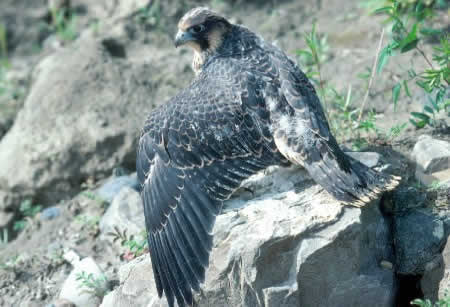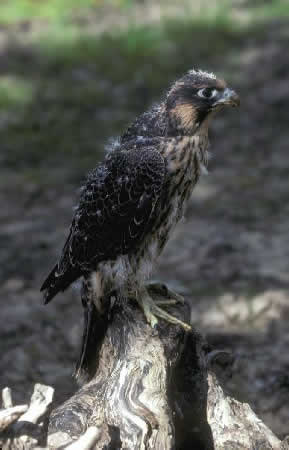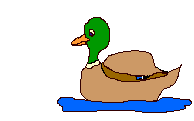|
 The
peregrine falcon belongs to the genus "Falco," which is characterized
by long pointed wings. In fact the word Falco is derived from "falx,"
the Latin word for sickle, in reference to the distinct sickle-shaped
silhouette of the peregrine falcon’s extended wings in flight. Also
unique to this species is the notched beak that is used to kill prey by
severing the spinal column at the neck. The peregrine falcon is a crow-sized
bird, weighing just over two pounds with a wing span of approximately
3 feet. An adult peregrine has a dark grey back and crown, dark bars or
streaks on a pale chest and abdomen, and heavy malar (cheek) stripes on
the side of the face. Immature peregrines are buff colored in front and
have dark brown backs; adults are white or buff in front and bluish-gray
on their backs. Females and males are identical in appearance, however,
the female can be a third larger than the male. The
peregrine falcon belongs to the genus "Falco," which is characterized
by long pointed wings. In fact the word Falco is derived from "falx,"
the Latin word for sickle, in reference to the distinct sickle-shaped
silhouette of the peregrine falcon’s extended wings in flight. Also
unique to this species is the notched beak that is used to kill prey by
severing the spinal column at the neck. The peregrine falcon is a crow-sized
bird, weighing just over two pounds with a wing span of approximately
3 feet. An adult peregrine has a dark grey back and crown, dark bars or
streaks on a pale chest and abdomen, and heavy malar (cheek) stripes on
the side of the face. Immature peregrines are buff colored in front and
have dark brown backs; adults are white or buff in front and bluish-gray
on their backs. Females and males are identical in appearance, however,
the female can be a third larger than the male.
Where
is the peregrine falcon found?
The peregrine
falcon has the most extensive natural distribution of any bird in the
world, limited only by high elevations, extreme heat, and extreme cold.
It is found on all continents except Antarctica. In most parts of the
world, it is absent only in the high mountains, in large tracts of desert
or jungle, and on isolated islands in the oceans. The American peregrine
falcon breeds in Mexico, the United States, and Canada.
How
did the peregrine falcon get its name?
Peregrine in
Latin is "Peregrinus," which means traveler. Peregrine falcons
are well known for their long fall and spring migratory flights to and
from their nesting and wintering habitats. The Arctic peregrine falcon
lives up to its name, breeding on the north slope of Alaska east across
northern Canada to Greenland in summer and migrating as far south as the
tip of South America to winter.
The
sport of falconry involves training falcons to hunt game, and people who
practice the sport are called falconers. Early falconers referred to peregrine
falcons as such because - unlike most birds use for the sport of falconry
- they were always trapped during migration, and not taken from the nest.
 How
fast can a peregrine falcon fly? How
fast can a peregrine falcon fly?
In level flight,
the normal speed for peregrines is about 40 to 55 miles per hour. In a
stoop (dive) peregrine falcons can attain speeds in excess of 200 miles
per hour as they attack their prey.
How
do they capture their prey?
Peregrine falcons
are aerial predators, feeding on live birds and an occasional bat, which
they capture in mid-air. Peregrine falcons often hunt in tandem, alternately
diving on their prey until it is caught.
Do
peregrine falcons have natural predators?
Peregrine falcons
are fast, aggressive, and fearless predators located at the top of their
food-chain; they rarely suffer from predation by other animals. Great-horned
owls and golden eagles are known to occasionally kill fledgling peregrines,
and less often, adults. Peregrine eggs sometimes fall victim to raccoons
and red-tailed hawks. The nestlings of ground-nesting Arctic peregrine
falcons may be preyed upon by grizzly bears and foxes.
 Do
peregrine falcons mate for life? Do
peregrine falcons mate for life?
Yes, peregrine
falcons are monogamous. They also breed in the same territory or area
for their entire lives. There are exceptions, such as when one mate dies
or is replaced by a stronger individual. Sexual maturity occurs during
the second year of life, followed by approximately one month of courtship.
In the spring, 3 or 4 eggs are laid. Incubation takes approximately 33
days and although both parents share incubating duties, the female performs
the greater share. Two or three chicks usually hatch and fledge in approximately
42 days. After fledging, young peregrine falcons are still dependent on
their parents for food until they learn to hunt, which takes about a month
and a half.
Do
peregrine falcons build nests?
Most birds build
nests made of sticks and soft natural fiber material in which their eggs
are incubated. Peregrine falcons lay their eggs in "scrapes,"
which are shallow indentations they scratch out with their talons in the
soft earth on the floor of their nests. Peregrine falcons typically nest
on ledges and in small shallow caves located high on cliff walls. They
have been known to use the abandoned nests of other birds, and on the
north slope of Alaska, commonly nest on the ground.
 When
do American peregrine falcons breed? When
do American peregrine falcons breed?
American peregrine
falcons begin breeding activities in the south earlier than in northern
States. In Arizona and coastal California, peregrines begin nesting in
late February and early March. In Alaska, nesting begins in May.
What
subspecies of peregrine falcon are native to North America?
There are three
subspecies nesting in North America:
-
The Arctic
peregrine falcon (Falco peregrinus tundrius) nests on the north
slope of Alaska east across northern Canada to Greenland, and winters
in Latin America.
-
The Peale’s
peregrine falcon (Falco peregrinus pealei) is a year-round resident
on the coasts of Washington, British Columbia, and Alaska north
to the Aleutian Islands.
-
The American
peregrine falcon (Falco peregrinus anatum) nests in southern Alaska,
Canada, United States and northern Mexico.
Peregrine falcons that nest in subarctic areas generally winter
in South America, while those that nest at lower latitudes exhibit
variable migratory behavior. Some are nonmigratory.
What
was the historical size of the American peregrine falcon population?
The historical
status of the American peregrine falcon is not known, but it was probably
never common, even when compared to other birds of prey. The limited historical
data suggest a best estimate of 3,875 nesting pairs. The decline of the
American peregrine falcon population began in the 1940s, was most pronounced
during the 1950s and continued through the 1960s into the early 1970s
throughout most of its range. By the time biologists realized the magnitude
of the American peregrine falcon decline, the population was only about
12 percent of what it had been prior to the introduction of modern pesticides.
 What
caused the near extinction of the peregrine falcon in North America? What
caused the near extinction of the peregrine falcon in North America?
The use of DDT
as a pesticide during the 1940s, 1950s and 1960s resulted in a precipitous
decline of peregrine falcons in North America. During this period of DDT
use, eggshell thinning and nesting failures were widespread in peregrine
falcons, and in some areas, successful reproduction virtually ceased.
As a result, there was a slow but drastic decline in the number of peregrine
falcons in most areas of its range in North America. DDE, a metabolite
of DDT, prevents normal calcium deposition during eggshell formation,
resulting in thin-shelled eggs that are susceptible to breakage during
incubation. Peregrine falcons feed near the top of the food chain and
suffered from the accumulation of DDE due to eating contaminated prey.
How
many American peregrine falcons were there when the bird was first placed
on the endangered species list?
The eastern population
of the American peregrine falcon was gone and the populations in the west
had declined by as much as 90 percent below historical levels. By 1975,
there were only 324 known nesting pairs of American peregrine falcons.
How
many American peregrine falcons are there today?
There are between
2,000 and 3,000 breeding pairs of American peregrine falcons in Canada,
Mexico, and the United States.
What's
the status of the peregrine falcon now?
Thanks to the
increase in peregrine falcon population, the U.S. Fish and Wildlife Service
was able to remove the species from the Federal list of threatened and
endangered species effective August 25, 1999. The peregrine falcon will
be monitored for several years to ensure that it no longer needs the protection
of the Endangered Species Act. If necessary, the species can be added
back to the list in the future.
Photo
credits: U.S. Fish and Wildlife Service
|

 The
wintry winds had already begun to whistle and the waves to rise
when the Drake and his mate gathered their half- grown brood together
on the shore of their far northern lake.
The
wintry winds had already begun to whistle and the waves to rise
when the Drake and his mate gathered their half- grown brood together
on the shore of their far northern lake.  "Honk!
honk! Danger, danger!" All descended in dizzy spirals, but
as the great Falcon swooped toward them with upraised wing, the
ducklings scattered wildly hither and thither. The old Drake came
last, and it was he who was struck!
"Honk!
honk! Danger, danger!" All descended in dizzy spirals, but
as the great Falcon swooped toward them with upraised wing, the
ducklings scattered wildly hither and thither. The old Drake came
last, and it was he who was struck!  Toward
spring, however, the Falcon's wing had healed and he could fly a
little, though feebly. The sun rose higher and higher in the blue
heavens, and the Ducks began to return to their cool northern home.
Every day a flock or two flew over the lake; but the Falcon dared
not charge upon the flocks, much as he wished to do so. He was weak
with hunger, and afraid to trust to the strength of the broken wing.
Toward
spring, however, the Falcon's wing had healed and he could fly a
little, though feebly. The sun rose higher and higher in the blue
heavens, and the Ducks began to return to their cool northern home.
Every day a flock or two flew over the lake; but the Falcon dared
not charge upon the flocks, much as he wished to do so. He was weak
with hunger, and afraid to trust to the strength of the broken wing.
 "Here,
children," boasted an old Drake, "is the very spot where
your father was charged upon last autumn by a cruel Falcon! I can
tell you that it took all my skill and quickness in dodging to save
my life. Best of all, our fierce enemy dropped to the ground with
a broken wing! Doubtless he is long since dead of starvation, or
else a Fox or a Mink has made a meal of the wicked creature! "
"Here,
children," boasted an old Drake, "is the very spot where
your father was charged upon last autumn by a cruel Falcon! I can
tell you that it took all my skill and quickness in dodging to save
my life. Best of all, our fierce enemy dropped to the ground with
a broken wing! Doubtless he is long since dead of starvation, or
else a Fox or a Mink has made a meal of the wicked creature! "
 The
peregrine falcon belongs to the genus "Falco," which is characterized
by long pointed wings. In fact the word Falco is derived from "falx,"
the Latin word for sickle, in reference to the distinct sickle-shaped
silhouette of the peregrine falcon’s extended wings in flight. Also
unique to this species is the notched beak that is used to kill prey by
severing the spinal column at the neck. The peregrine falcon is a crow-sized
bird, weighing just over two pounds with a wing span of approximately
3 feet. An adult peregrine has a dark grey back and crown, dark bars or
streaks on a pale chest and abdomen, and heavy malar (cheek) stripes on
the side of the face. Immature peregrines are buff colored in front and
have dark brown backs; adults are white or buff in front and bluish-gray
on their backs. Females and males are identical in appearance, however,
the female can be a third larger than the male.
The
peregrine falcon belongs to the genus "Falco," which is characterized
by long pointed wings. In fact the word Falco is derived from "falx,"
the Latin word for sickle, in reference to the distinct sickle-shaped
silhouette of the peregrine falcon’s extended wings in flight. Also
unique to this species is the notched beak that is used to kill prey by
severing the spinal column at the neck. The peregrine falcon is a crow-sized
bird, weighing just over two pounds with a wing span of approximately
3 feet. An adult peregrine has a dark grey back and crown, dark bars or
streaks on a pale chest and abdomen, and heavy malar (cheek) stripes on
the side of the face. Immature peregrines are buff colored in front and
have dark brown backs; adults are white or buff in front and bluish-gray
on their backs. Females and males are identical in appearance, however,
the female can be a third larger than the male.  How
fast can a peregrine falcon fly?
How
fast can a peregrine falcon fly? Do
peregrine falcons mate for life?
Do
peregrine falcons mate for life? When
do American peregrine falcons breed?
When
do American peregrine falcons breed? What
caused the near extinction of the peregrine falcon in North America?
What
caused the near extinction of the peregrine falcon in North America?